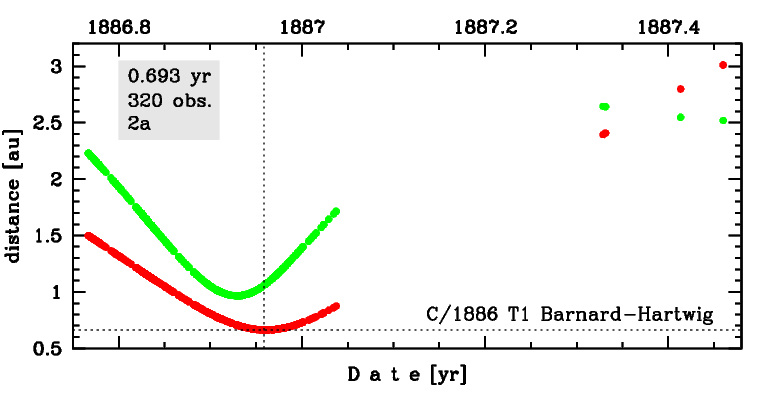C/1886 T1 Barnard-Hartwig
more info
C/1886 T1 was discovered on 5 October 1886 by Edward Emerson Barnard (Vanderbilt University Observatory, Nashville, Tennessee, USA). Independently, it was discovered on 6 October byErnst Hartwig (Bamberg Observatory, Germany). At the moment of discovery, the comet was about 2.5 months before its perihelion passage and was last seen on 17 June 1887 [Kronk, Cometography: Volume 2].
This comet made its closest approach to the Earth on 5 December 1886 (0.965 au), that is over 3 weeks after perihelion passage.
Solutions given here are based on data spanning over 0.693 yr in a range of heliocentric distances from 1.50 au through perihelion (0.663 au) to 3.01 au.
This Oort spike comet suffers tiny planetary perturbations during its passage through the planetary system; these perturbations lead to a little bit larger future semimajor axis (see future barycentric orbits).
C/1886 T1 was in the original sample of 19 comets used by Oort for his hypothesis on LPCs; however, according to presented here statistics for previous perihelion passage, dynamical status of this comet is uncertain.
See also Królikowska 2020.
This comet made its closest approach to the Earth on 5 December 1886 (0.965 au), that is over 3 weeks after perihelion passage.
Solutions given here are based on data spanning over 0.693 yr in a range of heliocentric distances from 1.50 au through perihelion (0.663 au) to 3.01 au.
This Oort spike comet suffers tiny planetary perturbations during its passage through the planetary system; these perturbations lead to a little bit larger future semimajor axis (see future barycentric orbits).
C/1886 T1 was in the original sample of 19 comets used by Oort for his hypothesis on LPCs; however, according to presented here statistics for previous perihelion passage, dynamical status of this comet is uncertain.
See also Królikowska 2020.
| solution description | ||
|---|---|---|
| number of observations | 320 | |
| data interval | 1886 10 07 – 1887 06 17 | |
| data type | perihelion within the observation arc (FULL) | |
| data arc selection | entire data set (STD) | |
| range of heliocentric distances | 1.5 au – 0.66 au (perihelion) – 3.01 au | |
| detectability of NG effects in the comet's motion | NG effects not determinable | |
| type of model of motion | GR - gravitational orbit | |
| data weighting | YES | |
| number of residuals | 546 | |
| RMS [arcseconds] | 3.80 | |
| orbit quality class | 2a | |
| orbital elements (heliocentric ecliptic J2000) | ||
|---|---|---|
| Epoch | 1886 11 30 | |
| perihelion date | 1886 12 16.99671464 | ± 0.00015454 |
| perihelion distance [au] | 0.66332091 | ± 0.00000156 |
| eccentricity | 1.00040438 | ± 0.00001334 |
| argument of perihelion [°] | 86.347923 | ± 0.000273 |
| ascending node [°] | 138.970618 | ± 0.000213 |
| inclination [°] | 101.614941 | ± 0.00028 |
| reciprocal semi-major axis [10-6 au-1] | -609.62 | ± 20.11 |
